Introduction
Business maintenance of late has been a challenge to many retailers even for multi-national companies. Expansion is much more daunting as enterprises are faced with risky and fast global changes that spell demand and supply in stormy ways: unpredictable.
Ikea, a Swedish brand sold at Asian prices (The Economist, 2006), has been seemed never to have stumbled since its launch as a leading furniture shop in Sweden, although it was noted that it failed in its first entry to Japan in 1974, and had to re-enter Lane, 2007). Ikea offers home furnishings with good and practical designs at affordable prices while doing it better, simpler and more efficiently. This has fit well in the localized international markets.
Discussion
IKEA: Background and Overview
Ikea was started by Ingvar Kamprad as a wallet, picture frame and pens seller. It became a furniture store in 1958, located in Almhult, Sweden. It was in the introduction of flat packs that Ikea started to gain dominance in furniture retailing. Flat packs are ready-to-assemble furniture of which Ikea has focussed on (Jennings, 2002). This is with the view to reduce storage space and delivery constraints.
Today, Ikea has become a leading furniture retailer offering a wide range of well-designed, affordable and functional home furnishing products. Ikea Group has grown into a major retailer with 128,000 co-workers in 24 countries or territories and annual sales of more than €21.1 billion. Its growth overview is illustrated below:
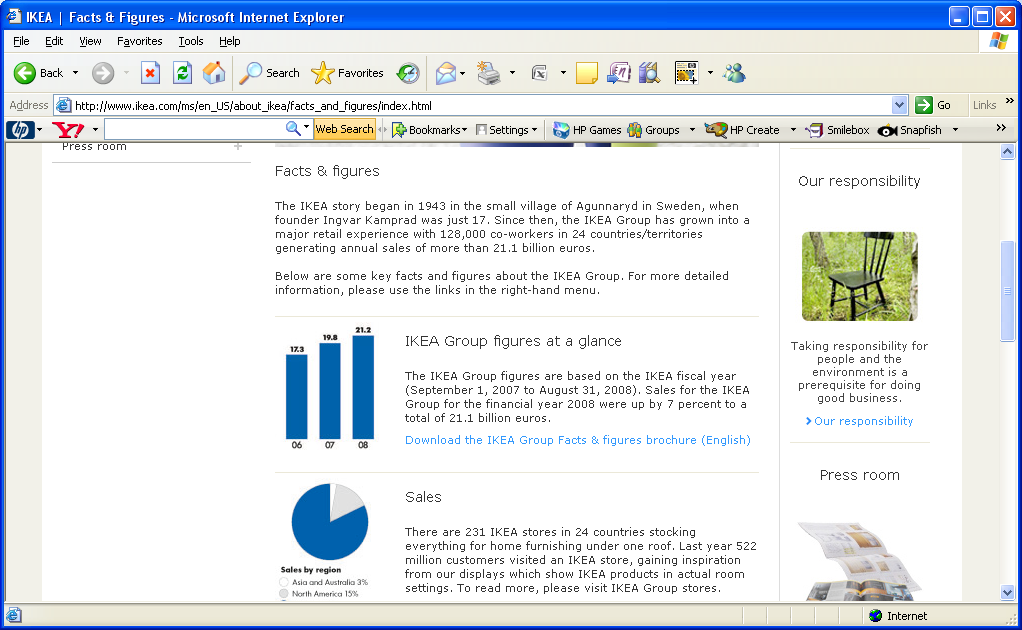
Ikea has also expanded in its retailing business as it included other products and restaurants aside from furniture. 247 Ikea stores worldwide are wholly owned by its INGKA Holding B.V. of which total is 279 in 24 countries. The rest are managed by the franchisees in 14 countries.
Internationalization
Internationalization is closely linked with globalization. Globalization is generally understood today as the easy international movement of goods, services and information facilitated by the advances in information and communication technologies (ICT) and transportation. Globalization has been hastened with the international political movements of countries through merging in organizations like the NATO and the European Union. This has influenced enterprises within a country to consider international opportunities. Internationalization is also an important factor in the continuing establishment of a business organization as globalization dictated a consumer-driven economy.
Strategies are always imperative in the global marketplace as there is diverse need and demands in every locality. The internationalization process is always accompanied by uncertainty as agreement about form is always a challenge. Geringer, Beamish, & daCosta (1989) also suggested that relationships between types of international strategies and results remain complex.
International Diversification
Notably, recent movements and adaptations in Ikea local outlets have pointed to diversification. International diversification is defined as “a strategy through which a firm expands the sales of its goods or services across the borders of global regions and countries into different geographic locations or markets,” (Hitt, Ireland, & Hoskisson, 2007, p 251). It has been viewed as a means of risk reduction (Geringer et al, 1989) and for gaining competitive advantage (Nachum and Zaheer, 2005). International diversification has significantly increased. As noted by the World Investment Report (2005), many multinational enterprises or MNEs in 2003 have operated on average with 49.5% of their employees, 49.*% of their assets, and 54.1% of their sales outside their home countries.
Aside from the mentioned objectives, other reasons why firms internationalize include access to new resources, extension of innovative capabilities, knowledge acquisition, location advantages, and performance improvements (Hitt et al, 2007). In addition, and in contrast to product diversification, international diversification also offers new means for value creation as there is direct access to foreign stakeholders, resources and institutions. It allows adjustment to existing core competencies, gain unique knowledge, and access substantial growth opportunities to markets previously limited to foreign countries.
Ikea’s early international entry shows the value creation potential by adding to its limited core products through product expansion even while in Sweden, as well as identifying the serving their existing customer base f young professionals and families in other countries. It was international diversification that made Ikea capable to serve its wide customer base worldwide (Bartlett and Ghoshal, 1989).
Today, Ikea is the international leader in its original market segment. Ikea sales by region are seen with Germany at 16%, USA at 10%, UK at 9%, France at 9% and Sweden at 7%.
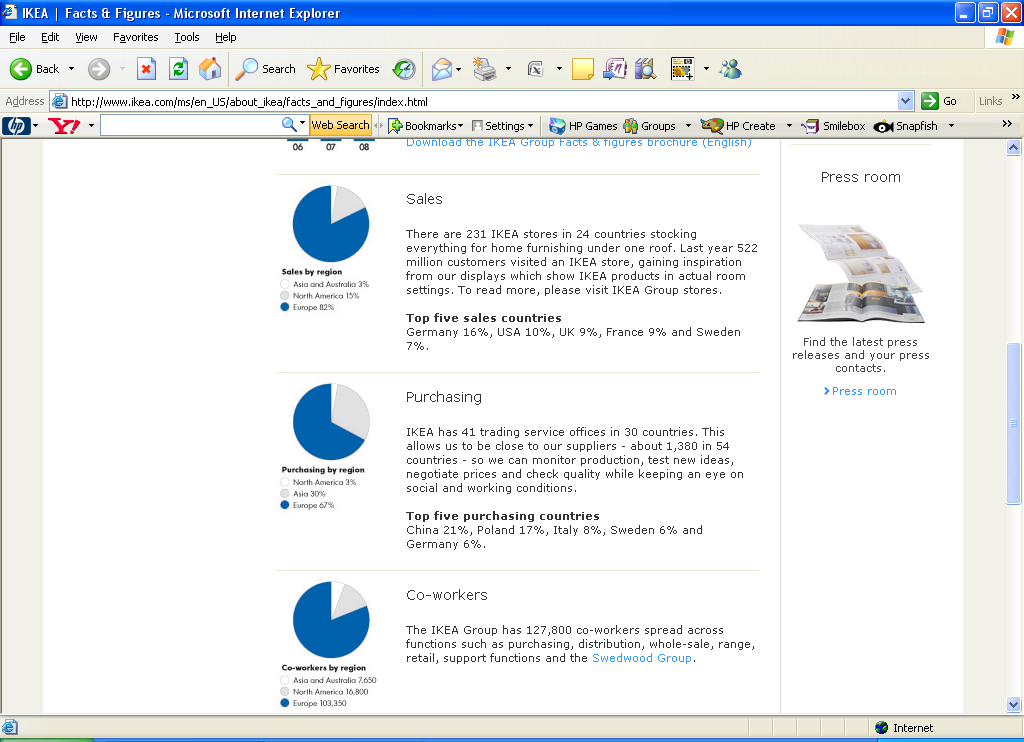
Firms are seen to have obtained new resources and transfer core competencies to new markets through this process. This has led to higher performance and risk-adjusted returns as noted by Werner (2002). Foreign direct investment facilitated removal of competition between subsidiaries or exploitation of subsidiary capabilities, lower transaction costs, improves control, facilitates the dissemination of information as well as choice for dispute resolution (Caves, 1996). In addition, product diversification also increases market power (Hitt et al, 2007), capitalize on economies of scale (Teece, 1982) use excess resources and reduction of transaction costs (Amit and Livnat, 1988).
For Ikea, through the maximized use of Swedish designs as well as food completed in various low-cost production sites scattered in Asia, Australia, North America, and Europe, all possible means to maintain competitiveness, especially at production cost and product affordability has been magnified.
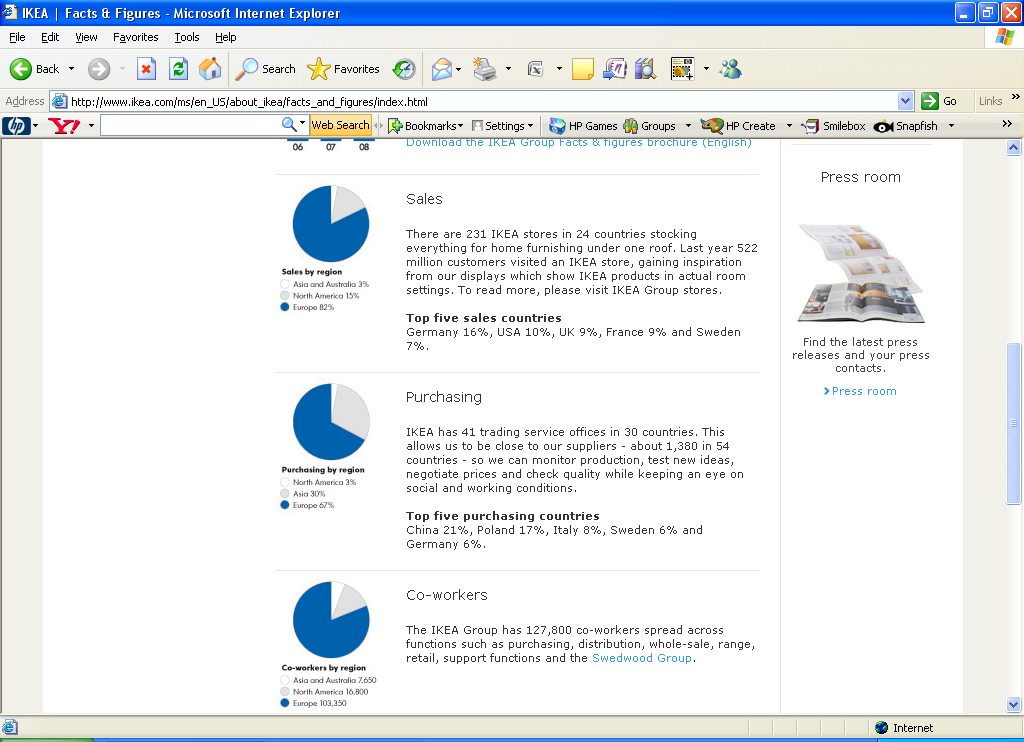
It is notable that through direct supervision of products from suppliers, quality is controlled and maintained, as well as the workplace quality and social lives of workers. However, costs are also lowered as competing suppliers are all scouted and considered to provide the most competitive price and quality requirements. As Ikea claimed, there is close monitoring and testing of introductory products, check quality, negotiate prices and impact on quality output.
Some diversification strategies adopted by Ikea include change of retail shops size such as those in Hong Kong. Shop space is not only limited in Hong Kong but also costly. Ikea opened three branches which are part of shopping malls. When compared to regular Ikea stores, the Hong Kong shops are small but are already big by Hong Kong standards.
Using the Retailer Internationalization Theory, this paper will continue to analyze and critically evaluate the international strategy of Ikea.
Retailer Internationalisation
According to Dawson (2007), retailing has shifted from being the sales agent of manufacturers to become production agent for consumers. Innovation recently added to the retailer internationalization process as ICT widens possibilities between manufacturers, retailers and consumers. Retailer internationalization is distinct from manufacturer internationalization as production is the focus of the latter. As for retailer internationalization, Dawson (2007) has proposed identifying characteristics as follows:
- The strategic objective for expansion is sales growth so that networking with foreign markets becomes inevitable. Against manufacturer internationalization, the retailer internationalization process seeks to reduce cost as applied by Ikea in order to compete with local sellers. Manufacturers outsource in order to keep prices low and competitive. But on the end-portion where consumers have to compare prices within their locality, Ikea has adopted the strategy to become competitive. Likewise, additional services have been provided for in Ikea stores such as the Swedish food in restaurants, Smaland play area section where children are deposited safely by their parents and collect after shopping, and long operating hours. Affordable set of meals are also offered such as a set of potato and Swede meatballs, hot dogs and drinks, cream and lingonberry jam for about US$1. The meal may include local varieties in other areas.
- Local nature of market dictates trends and competitiveness. International retailers target the local market. Large manufacturers on one end have global or international markets o which one product is saleable in Sweden as much as in the United States. By promoting the simplicity and practicability of furniture design in Ikea as Swedish in nature, it has also become an international campaign amongst local stores as there is a growing need for practical, affordable products that consumers easily take home without delivery hassles. Sensibility has become a global trait majority of consumers have adopted in a time of global financial constraints that fit well with the Ikea campaigns.
- The outlet is also the retailer’s product as Swedish-designed furniture sourced globally are sold in all Ikea stores adjusting mainly for conflicting names and demand. Today, Dawson suggested that retailers no longer sell items but services. Service for Ikea is affordability, practicality, and consciousness on the comfort of the consumer. Each Ikea outlet, although using the same prominent blue and yellow signage, out-of-city center locations to avoid high cost of rental and traffic problems, as well as warehouse-type one-way layout to maximize product exposure to consumers, has adopted localized mix of services and appearance. A notable store is the one located in Koblenz, Germany. It has used glass prominently for functional and aesthetic reasons: use of skylight to save on energy costs as well as boost employee morale and highlight products. The objective of localizing the product in its retail outlet is to create economic value as much as acceptability in a social, economic and political aspects depicting the MNC or Ikea itself (Dawson, 2007).
- The network structure of retail organizations is different in contrast with international manufacturers. It is comprised of dis-aggregated trading units with intra and inter-firm relationships. Its network efficiency works along with the internal trading unit with the links between head office to local units serving as a significant factor in overall efficiency (Dawson, 2007).
- Number of suppliers and customers characterize the retailer. It maintains a large portfolio of suppliers within a long-term or short-term relationship. Value is created within the relationship of suppliers as much as value in the relationship with customers. Manufacturers on the other hand, maintain value through physical items as it is of less significance than for retailers. Relationship between supplier and retailer is more dynamic as items for sale can be re-arranged, changed in a short period of time, but still, a retailer needs to be identified with core items. In the case of Ikea, provision of low-cost, self-assembled and practical household items and furniture has become its flagship identity. Ikea today has 41 trading services which means that it has established its own purchasing outfits in various localities internationally with purchasing activity as illustrated below:
- Cost structure. There is a difference between retailing and production costs. These are two different processes in firms. However, price competition and price discrimination are generally more active within the retailer scene and may easily sway local monopolies. Retailing costs are influenced by changes in commodity prices such as oil and nature of consumer demand. In addition, differences also apply to labor costs for both manufacturer and retailer (Dawson, 2007).

Internationalization of Ikea and Its Organisational Processes
Critical components of internationalization include the relationship of organizational size and structure, research and development intensity, size, performance, product diversification, and organizational age (Autio, Sapienza and Almeida, 2000). It is however, difficult to ignore the strategic resources and organizational processes of Ikea. Intangible resources have been closely linked with success in internationalization. It has been suggested that firms with strong human capital and relational capital with large corporate customers and with foreign governments have a higher probability of international market entry. All of the above-discussed point out the effective retailing formula of Ikea.
The Economist (2006), however, points out another intangible reason how Ikea has managed to grow exponentially. It was seen as “an outfit that ingeniously exploits the quirks of different jurisdictions to create a charity, dedicated to a somewhat banal cause, that is not only the world’s richest foundation, but is […] also one of its least generous,” (The Economist, 2006, P 2). Ikea’s set-up is seen to minimize tax and disclosure as well as handsomely rewarding the holding company led by its founder Ingvar Kamprad. Aside from immunity to takeover, Ikea has a complex organizational structure starting with its operator and parent company – the Ingka Holding, a private Dutch-registered company which is owned by the Stichting Ingka Foundation, also Dutch-registered, tax-exempt and non-profit legal entity. In reality, it has stopped being Swedish by the early 1980s. Ikea as a Dutch entity, was estimated to have been the Netherlands ‘ ten largest companies by market value if it had been listed as such. Ingka Holding had post-tax profits estimated at €1.4 billion ($1.7 billion). When compared to target, a US retailer with 1/5th of its sales come from home furnishings, Ingka Holding group is conservatively estimated to be worth €28 billion ($36 billion). As a foundation, however, Ikea is not forced to publish its accounts. Aside from this, it funnels foundation funds through another foundation – the Stichting Ikea Foundation with the goal to “build and reserve for securing the Ikea group, in case of any future capital requirements,” (The Economist, P 11). In addition to this complex structure, the Ikea trademark and concept is owned by another entity – the Inter Ikea Systems which is independent of Ingka Holding group and whose parent company is the Inter Ikea Holding registered in Luxemburg with undisclosed owners from Curacao.
The privileges and extreme measures to avoid taxation as well as making public financial statements such as the 2004 €590m “other operating charges” has been pointed out by critics to have helped kept Ikea products at low prices as well as its funds flowing in without problems accredited to their accountants (The Economist, 2006).
As outlined by Hermann and Datta (2005), the role of top executives in the decision to diversify internationally has been elucidated. Other factors for internationalization credited to executives include elite education, lower average age, and greater international experience of the top management team.
As pointed out by Alexander and Myers, assets owned by the firm are drivers of change. The firm’s advantages will work well in its internationalization process.
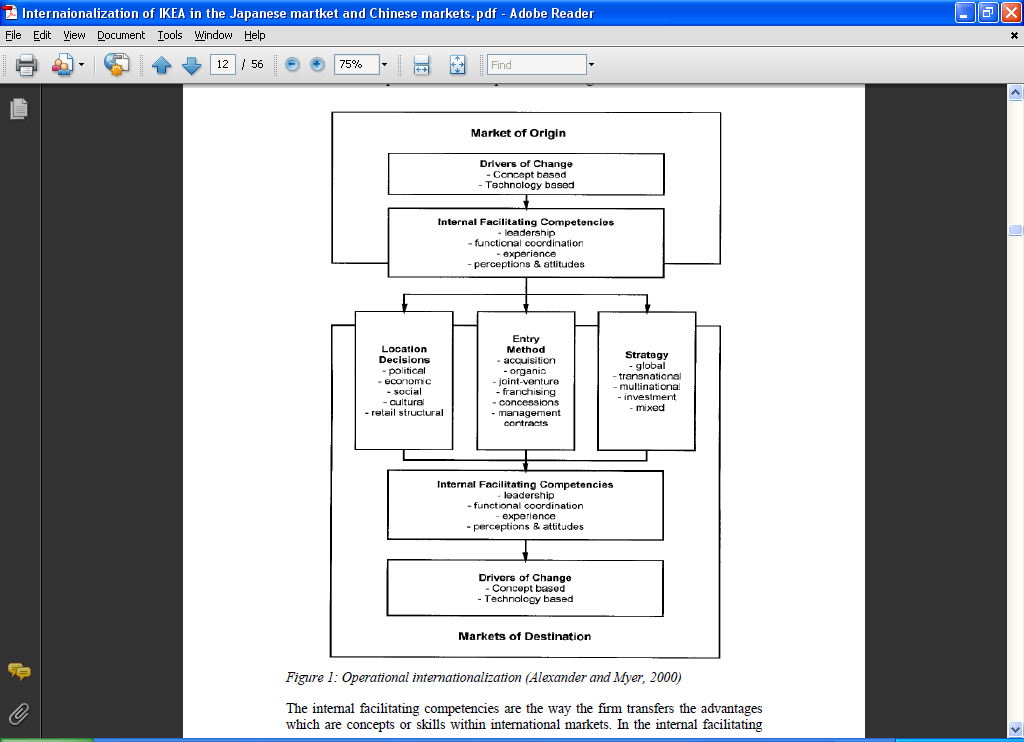
Internal competencies and advantages are transferred by the firm within its international markets so that the firm alone can decide what strategies to adopt, pick entry methods and location, as well as expand styles (Alexander and Myers, 2000).
Ikea Competitors
It was suggested that since retailing and furniture are the key Ikea characteristics, its competitors could be enumerated as furniture retailers such as Ashley Furniture HomeStore and Wal-Mart in the US, and Kingfisher in Europe. Ashley Furniture is one of the leading US furniture manufacturers and licenses its name to more than 300 Ashley Furniture HomeStores in the US, Canada, Mexico, Central America and Japan. Its structure, however, is far from the operating structure of Ikea as Ashley stores are independently owned and sell only the Ashley branded products (Hoover, 2009).
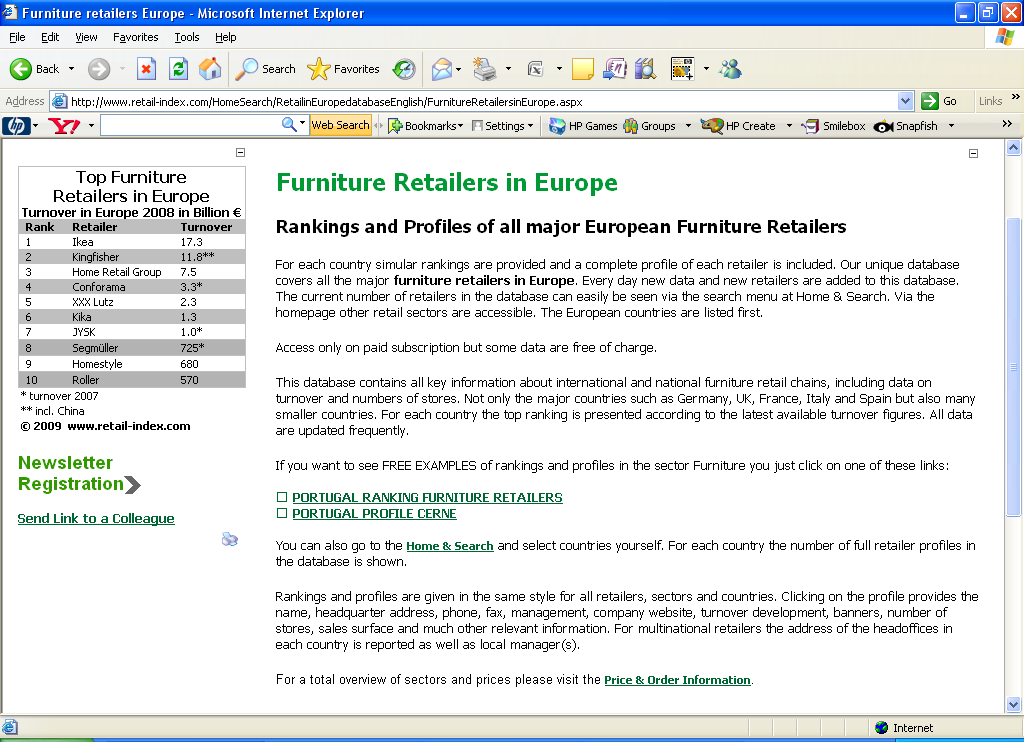
Kingfisher is another international retailer based in the United Kingdom which claims to be “the leading home improvement retail group in Europe and Asia” (Kingfisher, 2009, Homepage). It is focused on do-it-yourself business with 780 stores in 9 European and Asian countries with retail brands B&Q, Castorama, Brico Depot, Trade Depot and Screwfix (Kingfisher, 2009). An overview of its business and market is shown below:
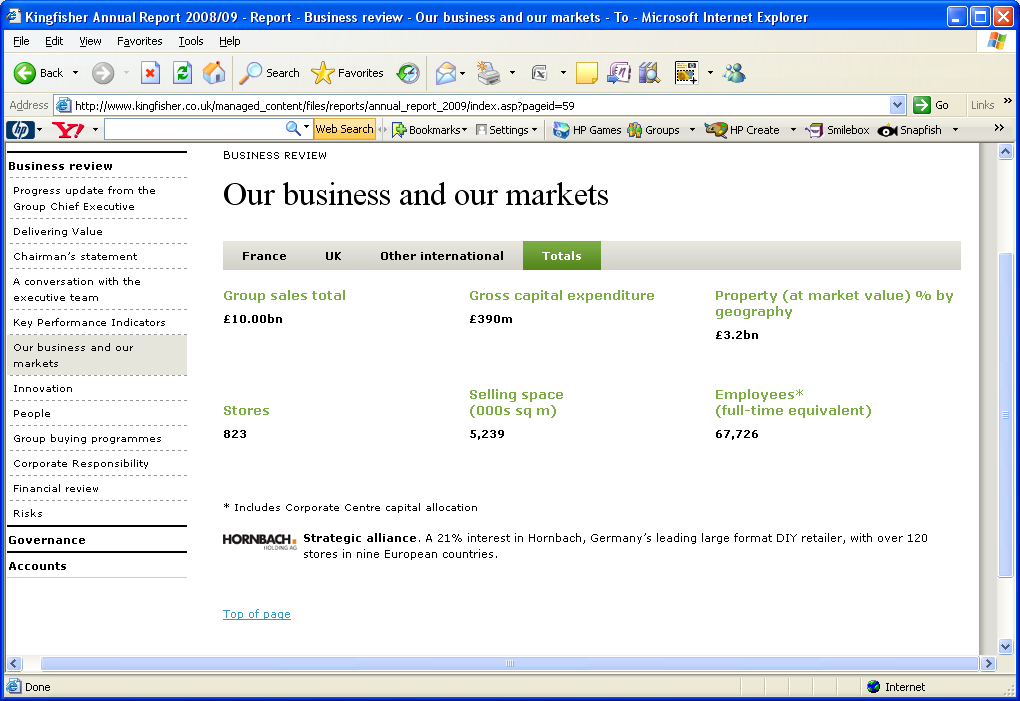
Conclusion
There are various reasons and factors that make or break the internationalization process of every enterprise. In fact, a lot of already established MNCs (or MNEs) have felt and responded to challenges from time to time in a variety of ways such as closure, declaration of bankruptcy, as well as selling to larger and leading firms at the moment.
For Ikea, its internationalization process has been effective not only for its retailer adaptability in local markets but for offering standard and flagship products: affordable, functional, practical self-assembled home furnishings that is acceptable at many levels of society, or to a wider market segment. The services provided no matter how trivial it may be such as long operating hours, trademark restaurants with equally affordable foods, maximized exposure of products to consumers through its layout and design, free play sections for children to the comfort shopping of parents or families, and product diversification are all well-placed measures that further delineate Ikea from other retailers, local or international.
Ikea’s adaption of ways and means to reduce costs – such as use of natural lighting, building of establishment and showrooms at low-traffic and low-rent areas, practical designs manufactured at low-cost-source countries is passed on to consumers, and happily as well as gratefully accepted through repeat and even anticipated consumption of more goods.
The financial as well as organizational structure, however, of Ikea is one that cannot be overlooked. It has established a labyrinth of organizations that layer one after the other in a maze that only financial geniuses will ever decipher. These measures aim to minimize risk on the part of its main stakeholders at the same time blurring financial obligations outside the organization. The trick may be working well with the consumers sharing on its benefits. However, for a tightly-knit process that is believed to be controlled only by one man, and that is the founder and suspected overall owner Kamprad, its sustainability might start unraveling once the brain behind the machination has lapsed. While this may not be prayed by this researcher, with the pressure of corporate social responsibility within and outside organizations, it always pays well to be legitimate in many business proceedings, including the selling of self-assembled furnishings. Selling, after all, will always be understood as a business activity and should behave as such to level the playing field which other organizations will push on, now or soon.
References
- Alexander, N. & Myers, H. 2000. ‘The retail internationalisation process.’ International Marketing Review 17 4-5, pp 334-353.
- Autio, E., Sapienza, H.J., & Almeida, J. 2000. ‘Effects of age at entry, knowledge intensity, and imitability on international growth.’ Academy of Management Journal, 5, pp 909-924.
- Geringer, J.M., Beamish, P.W., & daCosta, R.C.. 1989. ‘Diversification strategy and internationalisation: Implications or MNE performance.’ Strategic Management Journal, 10, pp 109-119.
- Hermann, P. And Datta, D.K. 2005. ‘Relationships between top management team characteristics and international diversification: An empirical investigation.’ British Journal of Management 16, pp 69-78.
- Hitt, M.S., Ireland, R.D., & Hoskisson, R.E. 2007. Strategic management: Competitiveness and globalisation (7th ed.). South-Western.
- Jennings, J. 2002. A Furniture Dealers Testament. Portfolio Books.
- Lane, C. 2007. ‘Failed Business in Japan: A study of how different companies have failed and tips on how to succeed in the Japanese market.’ Japan, Inc.
- Retail Index. 2009. ‘Top Furniture Retailers in Europe.’
- Teece, D.J. 1982. ‘Towards an economic theory of the multi-product firm.’ Journal of Economic Behaviour and Organisation, 3, pp 39-63.
- The Economist. 2006. ‘IKEA: Flat-pack accounting.’ 2006 (The Economist print edition).